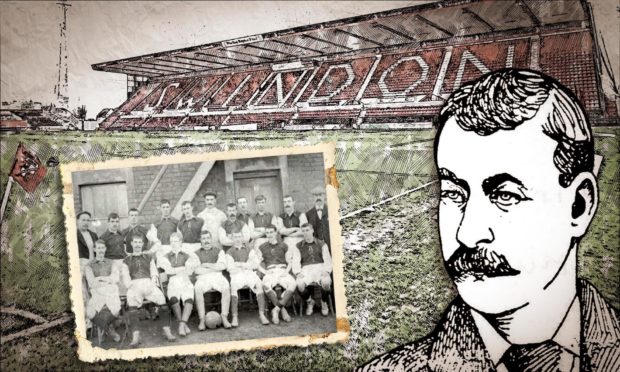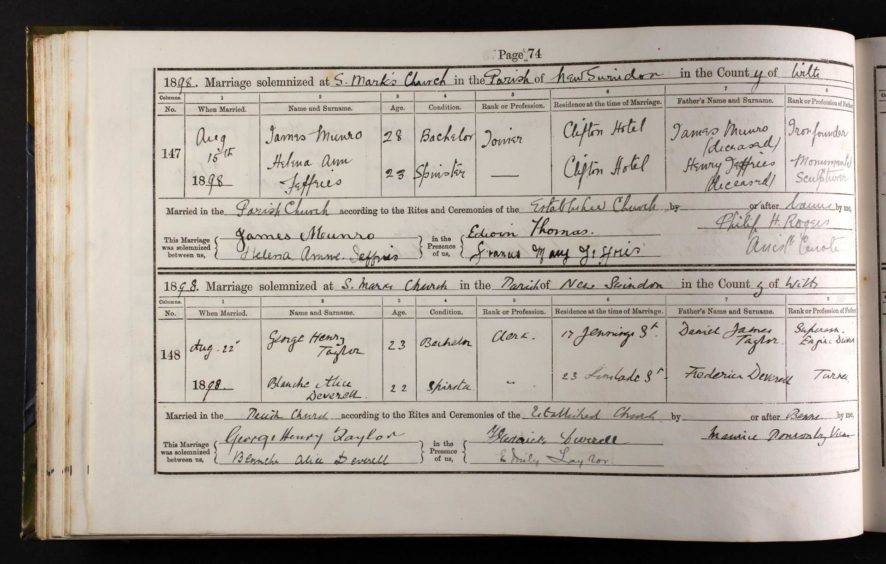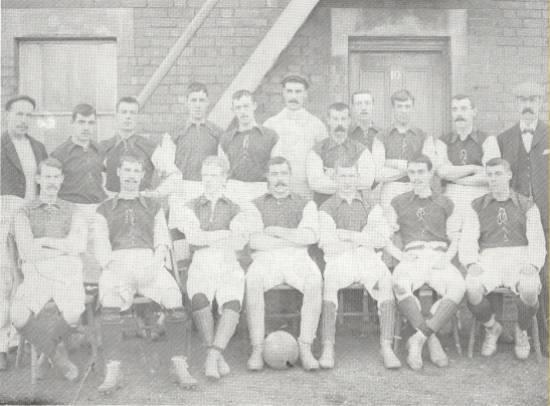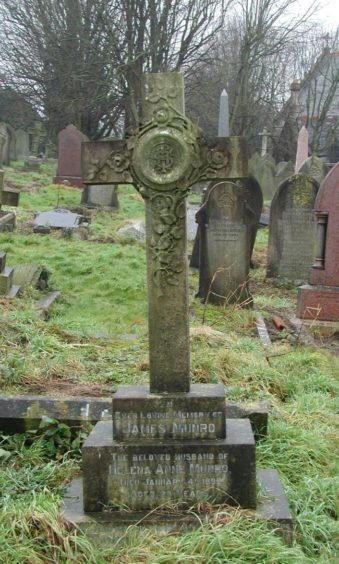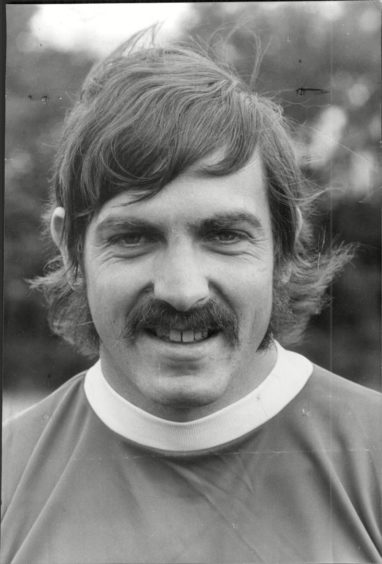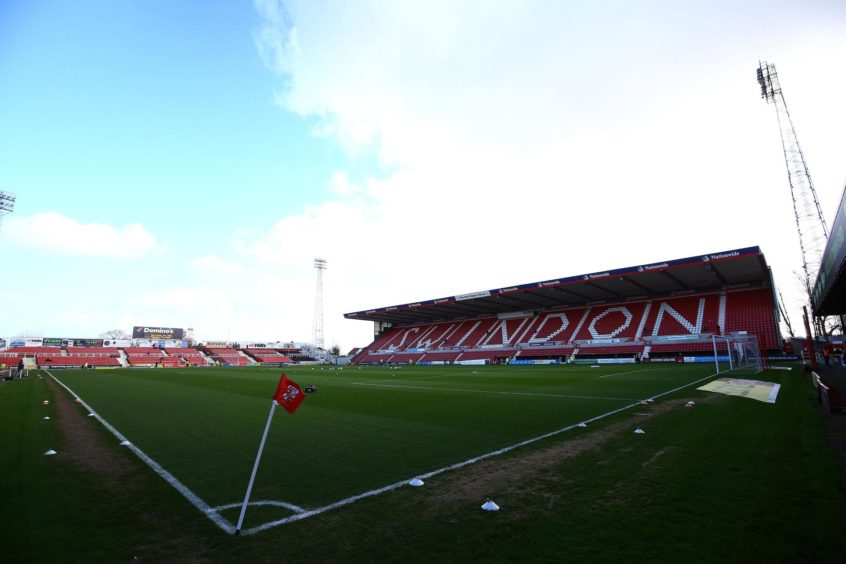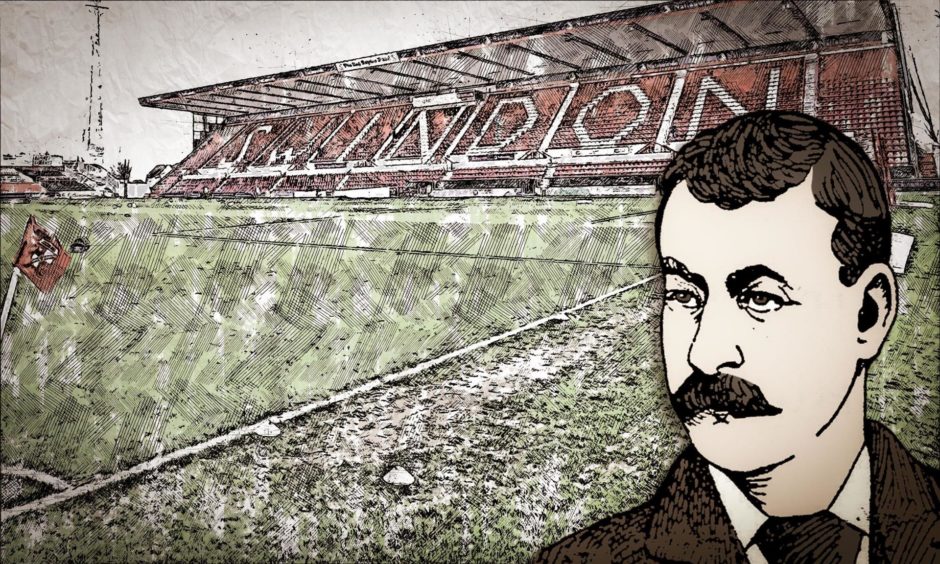Dundee-born football hero James Munro died days after picking up a chill as he led his Swindon Town side to victory over Tottenham.
Munro’s name is largely forgotten in Dundee but he is a legend in Swindon.
There are now plans to restore his grave to its former glory and hold a memorial service.
Munro was Swindon’s first paid captain.
Thousands of people lined the streets to pay their respects when he was laid to rest at the age of just 28 in 1899.
Born in January 1870, Munro quickly rose from junior to senior circles and played for Our Boys before he joined Strathmore at the age of 17.
Munro played alongside Billy Dickson who won his only Scotland cap while with Strathmore when he scored four goals on his debut against Ireland.
Munro played on the outside-left or outside-right for Strathmore.
He would follow Dickson to England, signing for Bolton in 1890 before a move to Burton Swifts in 1893.
Munro then joined Swindon in 1895 as centre-half and was given the captaincy after the club turned professional.
He was earning 35 shillings a week.
Munro was 5ft 5 inches tall and weighed 11-and-a-half stone but was described as “lion-hearted” with a “never-say-die” attitude despite his stature.
He played 73 games for Swindon, scoring 13 goals, and won Southern League representative honours.
Munro played his last game on Hogmanay in 1898
Munro appeared to have caught a cold after Swindon beat Tottenham 4-3 in a Southern League home game on New Year’s Eve in front of 6,000 fans.
Days later he was dead, leaving a wife behind, having recently been married.
Swindon Town fan James Turner is heading up a group of enthusiasts looking to raise money to restore his grave and trace any surviving relatives.
“I initially became aware of Munro after reading a book by local Swindon Town historian Paul Plowman,” said Mr Turner.
“Paul gave a detailed account of James Munro’s playing career as well as a general overview of his death which I followed up with my own research.
“It was quite possible playing in the cold was a contributory factor to his death.
“We may never know his health generally before the match and it was likely that even if he felt unwell he could have shrugged it off with a tot of whisky.
“And if he was of the character that was at his best when the chips were down he would have carried on.
“With possibly a loss of wages if he was unfit I am sure this would have been the case.”
Mr Turner still did not have Munro’s grave location or know if there was a headstone still standing due to the passage of time but he eventually located the memorial.
He said: “I suppose what struck me first of all was his tragic death with him being so young and recently married.
“Munro’s headstone was partially paid for by public subscription and therefore his death was felt personally by the local community.
“The people of Swindon wished to remember him by their own contributions, which were possibly only pennies or sixpences thrown into a collecting bucket.”
Thousands lined the streets to watch funeral cortege
Munro died on Wednesday January 4 1899 of pneumonia with the cause of death being officially registered as spinal meningitis.
Just a few days before, the club minute book noted a letter sent to the board members by his wife explaining how he was too ill to get out of bed and could not train.
The funeral cortege left Munro’s residence in Kent Road and preceded to the Trinity Presbyterian Church which was headed by the New Swindon Town Military Band.
Thousands turned out to watch Munro’s final journey.
The coffin was covered with beautiful wreaths, besides which a carriage was laden with floral tributes.
Members of the team acted as pall bearers.
Among those present were the directors, secretary and treasurer of Swindon Town, and representatives from Reading FC, Tottenham Hotspur FC, the Western League and the Southern League.
Among the floral tributes was one from his team-mates which bore the inscription: “Manfully he did his duty”, and the verse: “A star from out our ranks is gone; a light which shone the best; no more he’ll play the manly game, for Jimmy has gone to rest.”
Munro was a tough tackler with a never-say-die attitude
The directors paid his widow his full week’s wages following his death.
Mr Turner said: “He would be remembered by those Swindon supporters interested in the history of the club and the players of the club more than the passing of information to other supporters over the generations.
“Every generation has its own heroes mainly those who score the goals as their statistics say a thousands words.
“My hero was Don Rogers and to see him play each week was always special.
“So it would be special to have a hero who was remembered by his determination when the chips were down.
“What kind of player was he?
“I can only refer to the newspaper articles of the period and suggest even though he was of small stature he was a tough tackling never-say-die player who any team would want on their side.
“The reaction of the Swindon public at the time of his death would have been shock and grief because out of nowhere this tough individual who, according to general reports, played even though injured, was suddenly taken from them.
“As in most parts of the country at this time the Swindon fans would have had a close bond with their players, many of whom they would see on a daily basis and some players worked in the railways and the bond would have been so strong.
“Football was their outlet from the daily toil of long hours including a half day on Saturday so these players were their heroes and the newspaper reports of his funeral only demonstrate the high esteem he was held.”
Small service would take place after grave restoration
Mr Turner said Munro’s grave is generally deteriorated and the plans are to restore it to its original condition.
The monument will be restored rather than being altered in any way and will include only existing wording.
“After renovation an event to be held to re-dedicate the grave and to recognise the achievements of James Munro laid to rest so far from his home town and bring together interested parties who had an association with his career,” he said.
“We would also look to replicate some of the events of his funeral and to have a small service.
“We want to raise people’s awareness of the pioneers of the people’s game like James Munro who travelled in order to pursue their dream.
“It would be ideal if we could trace any relatives of James who wish to make contact.
“The true cost of the renovation is to be determined and would be raised by public funding.
“Although in an ideal world a kind monumental mason from Swindon or even Dundee who would like to do it just for the love of it would be welcome.”
The grave of Swindon Town FC’s first manager, Sam Allen, was restored to its former glory in 2014 by enthusiasts after it became derelict and overgrown.
Allen joined the club’s committee in 1895 when Munro was a player and campaigners restored it to mark the 100th anniversary of Swindon winning the Southern League.
Anyone who can help the project to restore Munro’s grave or is a family member of Munro can contact James Turner at james.turner3@ntlworld.com.
James Munro in his own words
Munro was interviewed by the Football Star in December 1895 where he was asked about his career journey before signing for Swindon.
“I did a lot of kicking about as a lad but my first experience with a decent club was when, at the age of 17, I joined Strathmore (Dundee),” he said.
“Amongst my comrades were Dickson, who is now playing for Stoke, and Matthews, of Millwall Athletic.
“I used to fill the outside-left or outside-right position.
“When I was 20 I went to the Bolton Wanderers whom I assisted for three years – first as outside-left with McNee as a partner, and afterwards as outside-right.
“In 1893 I transferred my services to Burton Swifts, and for two seasons figured at inside-left with Elkins, who is now at Luton.
“We were credited with being the best left-wing in the Second Division of the league.
“I have played against every team in the First and Second divisions bar Loughborough and have filled every position on the field but goal.
“I was in the Bolton Wanderers’ eleven which beat Darwen in the final of the Lancashire Cup in 1891, and in the semi-final we had accounted for Blackburn Rovers.
“I was also fortunate enough to score two goals against Aston Villa on their own ground when the Wanderers beat them there.”
Asked his opinion on the Swindon Town team, Munro said: “Well, for a club which has only recently adopted professionalism, we have, in my opinion, done remarkably well.”
Munro was also included in the book Association Football & The Men Who Made It which is arguably the holy grail for any serious collector of football literature.
Alfred Gibson and William Gibson’s book is seen as the “indispensable work on the birth and development of football” and covers the sport’s Victorian origins.
The book described Munro as a “devoted servant” who was “without a superior” at centre-half in the Southern League and did “magnificent work for Swindon until death laid its chilly hand on him in the early part of 1898”.
